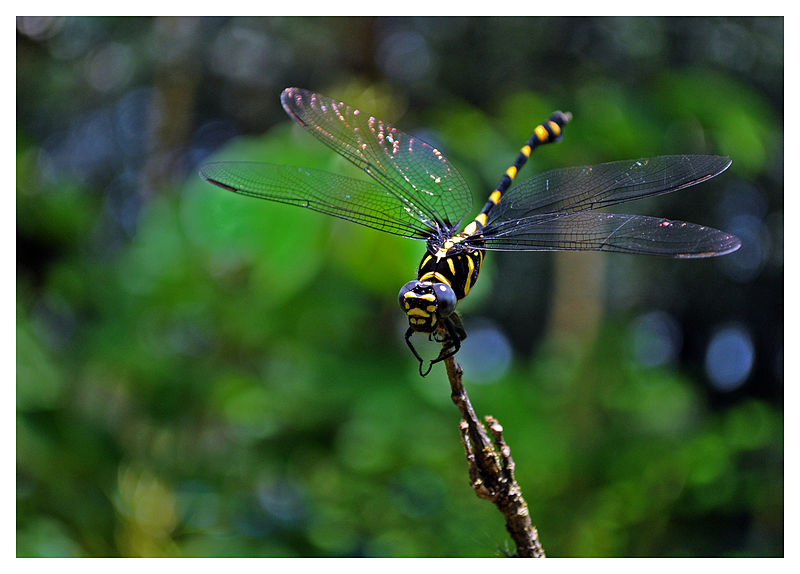Quick links
horse-stinger
DCHP-2 (Mar 2014)
n. — Newfoundland, Fauna, dated
a dragonfly.
Type: 2. Preservation — The term horse-stinger is a vernacular name for "dragonfly", the large flying insect (see Image 1, see the 1966 quotation). Clarke (2010b: 106) labels horse-stinger a preservation from southwest England. Accordingly, the term is marked as dialectal English in American English (see W-3, s.v. "horse-stinger") and the earliest attestation in OED-3 is from a British source in 1773 (see OED-3, s.v. "horse-stinger"). The term horse-stinger is used to portray English versus Irish settlement patterns in Newfoundland; Paddock (1984: 15) shows that English-settled areas of the island predominantly use this British term, whereas the Irish-settled southern Avalon Peninsula uses "devil's darn(ing) needle" or "devil's needle" from Irish English (Clarke 2010b: 120). The term has enjoyed longer use in Newfoundland than in mainland Canada. Today the term is marked as dated; it is preserved in place names (see the 2012 quotation).
The term is one of the traditional North American variables in dialectology (see, e.g., DARE). The name horse-stinger is said to derive from their habit of lingering around horses and cattle (see the second 1975 quotation). Moreover, it is often discussed as a misleading name rooted in superstition, as they are indeed harmless insects (see the first 1975 quotation) that are "incapable of stinging or biting" (see the 1994 quotation). As Chart 1 shows, horse-stinger is quite frequent in Canada and the US, only outnumbered by Australia. In the North American context, the term is, by virtue of frequency and certain Canadian tendencies towards preservation (Dollinger 2015a, 2015c), perhaps more Canadian than American.
See also DNE, s.v. "horse-stinger", DARE, s.v. "horse stinger", EDD, s.v. "horse-adder".
The term is one of the traditional North American variables in dialectology (see, e.g., DARE). The name horse-stinger is said to derive from their habit of lingering around horses and cattle (see the second 1975 quotation). Moreover, it is often discussed as a misleading name rooted in superstition, as they are indeed harmless insects (see the first 1975 quotation) that are "incapable of stinging or biting" (see the 1994 quotation). As Chart 1 shows, horse-stinger is quite frequent in Canada and the US, only outnumbered by Australia. In the North American context, the term is, by virtue of frequency and certain Canadian tendencies towards preservation (Dollinger 2015a, 2015c), perhaps more Canadian than American.
See also DNE, s.v. "horse-stinger", DARE, s.v. "horse stinger", EDD, s.v. "horse-adder".
Quotations
1846
TOCQUE 269 In Newfoundland these [dragon] flies are generally called horse-stingers, though they do not possess the power of stinging.
1957
Dragonflies have been given many common names. Some are quite fantastic - horse-stinger, flying-adder, snake-feeder, virgin-of-the-waters and devil's-darning-needle - to name but a few. Who, living in this country, has not heard adults warn children to beware of telling lies, lest the devil's darning needle sew up their lips?
1966
(14) LARGE, BIPLANE INSECT. The large, distinctive, flying insect with two pairs of gauzy wings has only one vernacular name in Carbonear. The name is horse-stinger [...]. One informant, a member of one of the "old elite" families and educated abroad, used only dragon-fly. His nephew stated that the insect was in fact a dragon-fly, but that it was locally known as a horse-stinger.
1975
Centuries of science have not cured us of our superstitions, including those surrounding the harmless dragonfly. We call them "devil's darning needles" or "green darners" because they supposedly sew up the lips and eyelids of the sleeping. Their name in Norwegian is oyestikker or "eye-stinger." From their habit of hovering near cattle and horses has arisen the name "horse-stinger." The name dragonfly itself is one of strangeness and legendary power.
1984
Eli ignores that folk wisdom about the "'horse stinger,' as people called the dragonfly", and is supported by the school teacher who informs him that in fact it had no sting [...] As Horwood records, "horse-stinger" is a common local name for the dragonfly: according to one Newfoundland source. These harmless insects were called "arse-stingers", "horse-stingers" or "hoss-stingers". Children believed they could be badly stung by one of these.
1994
As a child, Eli kept a dragonfly as a pet, even though the insect was known locally as a devil's darn-needle or horse-stinger, and was reputed to have a deadly sting - a belief made all the more ridiculous by the fact that, as one of his early teachers informed him, the insect is incapable of stinging or biting.
2001
In those days, Mr. Rice had a standing reward to neighbourhood boys of a penny (worth two cents) or a copper (one cent) for what we called horse-stingers (dragonflies, I later learned). Payment depended on the condition of the large flying insect, dead or alive, but not if it was squashed or if the wings were busted up.
References
- Clarke (2010b)
- DNE
- DARE
- OED-3
- EDD
- W-3
- Paddock (1984)
- Dollinger (2015c)
- Dollinger (2015a)
Images
